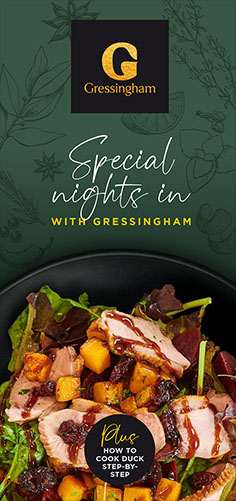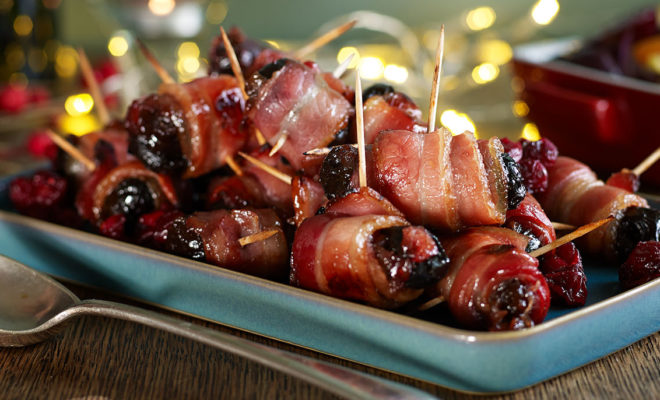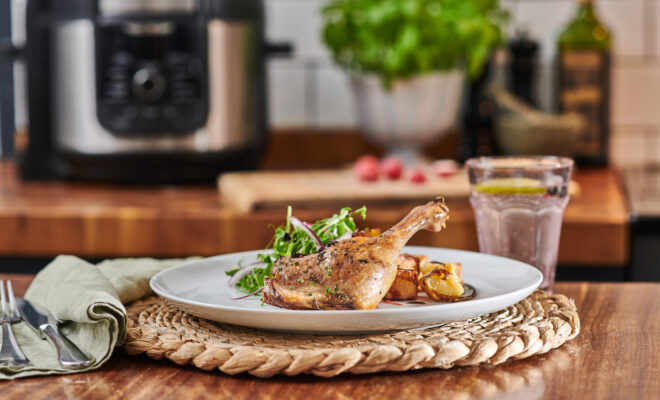How to cook duck with ProCook
We have teamed up with the team at the ProCook cookery school to put together some top tips on cooking with duck. To help you get the most out of your duck at home, ProCook have compiled the very best tips to showcase proper duck cooking methods and know-how. From duck breast and duck legs, to using the right cooking equipment, find everything you need to know to cook the perfect duck each and every time in this article.
How to Cook Duck Breast
Score the Skin
Cutting the fat encourages it to render – or melt – more quickly when cooking. It also helps the duck remain in sharp, reducing the changes of warping and becoming more difficult to work with once cooked.
Score the fat on the duck breast without cutting into the meat itself. Maximise clean, precise lines by using a sharp, quality knife. The ProCook Micarta X50 Chefs Knife is ideal due to its multi-functional, super sharp blade that will effortlessly glide through the duck’s fat with accuracy and ease.
Season
Seasoning depends on the recipe you’re following, so be sure to check you have the herbs, spices and marinades asked of you before you start prepping the duck breasts. Experiment with duck breast by infusing it with paprika, cumin and chili powder for extra spice.
PROTIP
When seasoning your duck breast with salt and pepper or a marinade, there’s no need to add oil or butter. Duck has plenty of natural fat that will seep out as it cooks, adding flavour and moisture.
Pan-Fry Your Duck Breast
Remember, oil, butter or any grease isn’t required due to the duck’s natural fat. However, non-stick frying pans are fantastic for cooking duck breast as their non-stick coating offers phenomenal food release and heat distribution, so all your cuts of breast remains juicy and tender in the middle and crisp on the outside.
When searing, extra love and care is required when it comes to duck breast.
Allow the Duck Breast to Rest
Duck needs to rest for approximately 5-10 minutes after being pan-fried. Use a spiked carving board as it provides a stable place for the duck breast to rest and be carved. By resting, you allow the juices to redistribute themselves, enhancing duck’s succulent texture.
Carving duck breast can be simple. Use a sharp chefs knife to slice against the grain and into a slice thickness of your choosing.
Serve in Style
Serving your pan-fried duck breast depends on the dish in question. You can carve into slices and serve on a bed of vegetables and top with a jus, top a salad, or serve on the side of roast potatoes and root vegetables.
How to Cook Duck Legs
Remove Excess Moisture
Pat the skin of the duck legs with a kitchen towel to remove excess moisture. Too much moisture can affect the juiciness of the duck leg, while also impacting cook times and quality.
Prick the Skin
Rather than score, prick the skin of the duck legs all over. You can do this by using a thick toothpick or wooden kebab stick – anything that can pierce the skin. Like scoring, this allows the fat to melt.
Once the skin has been pierced, season the duck legs with your desired salt, pepper, herbs and spices. Again, avoid adding butter or oil.
Oven Bake and Baste
- Place the duck legs skin side up in an oven dish and cook in the middle of an oven (180C / 160C Fan) for approximately 90 minutes or until the skin is brown and crispy.
- By using a Stoneware Oven Dish with deep sides, you can easily hold the juices for extra succulence while providing consistent heat distribution for even browning and baking.
- Baste the duck legs while cooking by safely removing the oven dish using a tea towel and ladling the juices over the legs. Do this several times.
- Use a meat thermometer in the thickest part of the duck leg and remove once it reaches a temperature of 80C.
Cover and Rest
Once cooked through, remove the duck legs from the oven and cover with foil, allowing the legs to rest in a warm place for 10 minutes. Simply take the oven dish to the table to serve once ready!
More ProTips for Cooking Duck
Save the duck fat for roast potatoes. The fat is great for crisping up potatoes and adding rich flavour.
Make duck crackling by removing and cutting the skin into thin strips and frying until crisp and golden. Add to salads, top roast potatoes, or add crunch to your desired duck dishes.
Make a one-pot meal by cooking duck legs with seasonal vegetables for an easy and delicious weekend roast.
Sign up and get your free recipe booklet
Download your free recipe book to get access to a host of deliciously flavoured recipes and a world of global cuisine.




